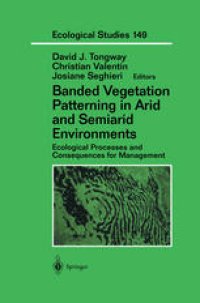
Ebook: Banded Vegetation Patterning in Arid and Semiarid Environments: Ecological Processes and Consequences for Management
- Tags: Ecology, Plant Sciences, Landscape/Regional and Urban Planning, Environmental Management
- Series: Ecological Studies 149
- Year: 2001
- Publisher: Springer-Verlag New York
- Edition: 1
- Language: English
- pdf
Aerial photography has revealed the striking, widespread phenomenon of repeating patterns of vegetation in more arid areas of the world. Two interdependent phases, bands of dense and sparse vegetation, alternate in the landscape. This volume synthesizes half a centurys accumulated knowledge of both theoretical and applied landscape functions from a variety of these regions. It covers structure, dynamics, and methods of study, as well as disturbances to these landscapes and relevant management issues. Chapters are included to discuss the role of modeling in answering questions about the origins and complex processes of banded landscapes. Studies of banded landscapes have yielded valuable lessons for understanding other semi-arid landscapes as well, leading to a knowledge base facilitating sustainable use and rehabilitation.
Aerial photography has revealed the striking, widespread phenomenon of repeating patterns of vegetation in more arid areas of the world. Two interdependent phases, bands of dense and sparse vegetation, alternate in the landscape. This volume synthesizes half a centurys accumulated knowledge of both theoretical and applied landscape functions from a variety of these regions. It covers structure, dynamics, and methods of study, as well as disturbances to these landscapes and relevant management issues. Chapters are included to discuss the role of modeling in answering questions about the origins and complex processes of banded landscapes. Studies of banded landscapes have yielded valuable lessons for understanding other semi-arid landscapes as well, leading to a knowledge base facilitating sustainable use and rehabilitation.
Aerial photography has revealed the striking, widespread phenomenon of repeating patterns of vegetation in more arid areas of the world. Two interdependent phases, bands of dense and sparse vegetation, alternate in the landscape. This volume synthesizes half a centurys accumulated knowledge of both theoretical and applied landscape functions from a variety of these regions. It covers structure, dynamics, and methods of study, as well as disturbances to these landscapes and relevant management issues. Chapters are included to discuss the role of modeling in answering questions about the origins and complex processes of banded landscapes. Studies of banded landscapes have yielded valuable lessons for understanding other semi-arid landscapes as well, leading to a knowledge base facilitating sustainable use and rehabilitation.
Content:
Front Matter....Pages i-xiv
Banded Vegetation Patterns and Related Structures....Pages 1-19
Theories on the Origins, Maintenance, Dynamics, and Functioning of Banded Landscapes....Pages 20-31
Specific Methods of Study....Pages 32-51
Runoff and Erosion Processes....Pages 52-76
Soil Water Balance....Pages 77-104
Soil Biota in Banded Landscapes....Pages 105-131
Vegetation Dynamics: Recruitment and Regeneration in Two-Phase Mosaics....Pages 132-145
Multiscale Modeling of Vegetation Bands....Pages 146-166
Landscape Models for Banded Vegetation Genesis....Pages 167-197
Productivity of Patterned Vegetation....Pages 198-209
Toward Improved Management of Arid and Semiarid Banded Landscapes....Pages 210-227
Banded Landscapes: Ecological Developments and Management Consequences....Pages 228-243
Back Matter....Pages 245-254
Aerial photography has revealed the striking, widespread phenomenon of repeating patterns of vegetation in more arid areas of the world. Two interdependent phases, bands of dense and sparse vegetation, alternate in the landscape. This volume synthesizes half a centurys accumulated knowledge of both theoretical and applied landscape functions from a variety of these regions. It covers structure, dynamics, and methods of study, as well as disturbances to these landscapes and relevant management issues. Chapters are included to discuss the role of modeling in answering questions about the origins and complex processes of banded landscapes. Studies of banded landscapes have yielded valuable lessons for understanding other semi-arid landscapes as well, leading to a knowledge base facilitating sustainable use and rehabilitation.
Content:
Front Matter....Pages i-xiv
Banded Vegetation Patterns and Related Structures....Pages 1-19
Theories on the Origins, Maintenance, Dynamics, and Functioning of Banded Landscapes....Pages 20-31
Specific Methods of Study....Pages 32-51
Runoff and Erosion Processes....Pages 52-76
Soil Water Balance....Pages 77-104
Soil Biota in Banded Landscapes....Pages 105-131
Vegetation Dynamics: Recruitment and Regeneration in Two-Phase Mosaics....Pages 132-145
Multiscale Modeling of Vegetation Bands....Pages 146-166
Landscape Models for Banded Vegetation Genesis....Pages 167-197
Productivity of Patterned Vegetation....Pages 198-209
Toward Improved Management of Arid and Semiarid Banded Landscapes....Pages 210-227
Banded Landscapes: Ecological Developments and Management Consequences....Pages 228-243
Back Matter....Pages 245-254
....